Dreamy Homemade Vegan Tiramisu Recipe (Easy & Delicious)

Easy. Decadent. Vegan. Tiramisu.
Y’all, I have tested, re-tested, and re-tested this vegan tiramisu recipe so many times, I could make this in my sleep! I took this classic Italian dessert as a personal challenge when my husband (who is Italian American) told me that it was not just one of his favorite desserts, but his “all time favorite dessert.” Whether or not you’ve had a traditional tiramisu, this vegan version will not disappoint! Like a classic tiramisu, this easy vegan tiramisu recipe is composed of the following:
- Spongy vegan ladyfingers
- Stiff vegan mascarpone cream
- Deep espresso syrup
- Dusting of cocoa powder
If this is your first time or hundredth time making a “pick me up” (what “tiramisu” literally means in Italian), I promise you that this recipe is the perfect dessert for a special occasion, holiday gatherings, or any random Sunday.
Now, with that, let’s dig into this vegan tiramisu recipe!
- Origin Story: Was Tiramisu the “Viagra” of its Time?
- How To Make This Vegan Tiramisu the BEST Vegan Tiramisu.
- What Are the Main Components of this Vegan Tiramisu?
- Key Ingredients and Notes on Substitutions for Vegan Tiramisu.
- Equipment You’ll Need for this Vegan Tiramisu.
- How to Make the Components of the BEST Vegan Tiramisu.
- How to Assemble Your Vegan Tiramisu.
- The Hardest Part of this Vegan Tiramisu Recipe.
- Storing Your Vegan Tiramisu.
- Video: Watch Me Make It!
- Frequently Asked Questions.
- Recipe Card
- Questions & Comments
Disclaimer: Some of the links in this post may be affiliate links for products I use and love. If you make a purchase after clicking one of those links, I may earn a small affiliate commission, perhaps enough to buy some extra gochujang or gochugaru 🙂
Origin Story: Was Tiramisu the “Viagra” of its Time?
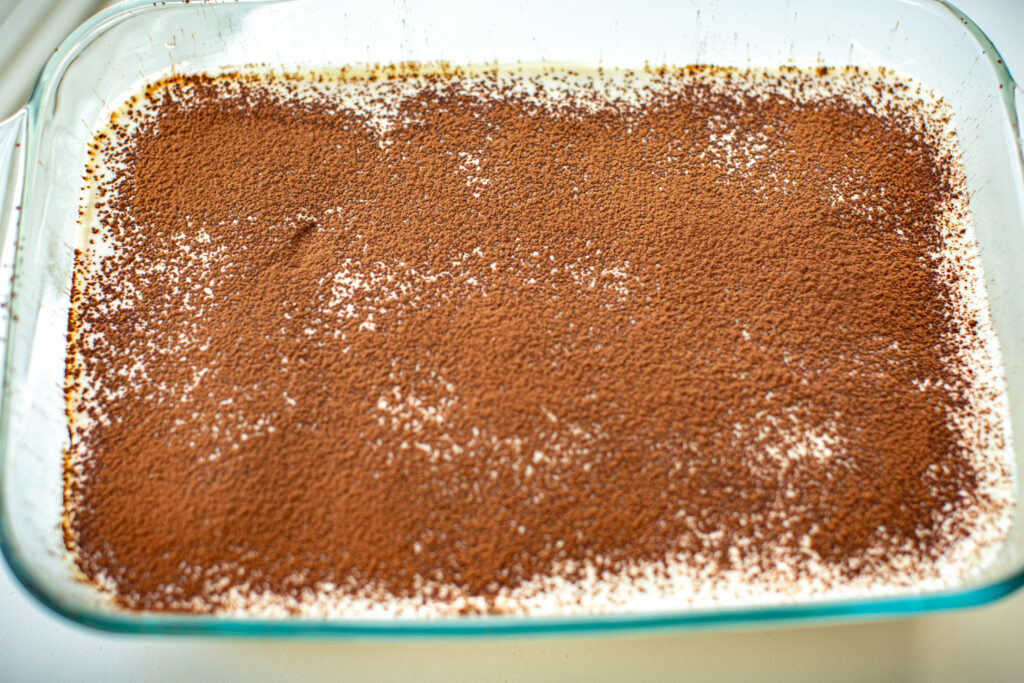
Here’s the problem with trying to replicate traditional versions with vegan desserts: it assumes one, uniform “traditional version.” The truth is that for most recipes, there isn’t one “traditional” way to make them. This seems particularly true for Italian recipes, where the “traditional” version of a dish in one region could be unrecognizable in another (just a few miles away).
For tiramisu, it isn’t even clear how or when this sweet casserole emerged as the icon of Italian desserts. Its first appearance in cookbooks was in the 1960s, though many believe the dish predated publication for quite some time. Some believe the dish originated in the royal palaces of the 18th century, while others claim that an innovative madam began serving this “pick me up” to her brothel clients because of its aphrodisiac qualities.
It seems, however, that the earlier versions of tiramisu consisted of ladyfingers, egg yolks, sugar, mascarpone, coffee, and cocoa powder. Since then, we’ve seen the addition of whipped cream, marsala wine or coffee liqueur, dark chocolate shavings, and even the replacement of ladyfingers with different cookies or sponge cake (which really transforms tiramisu into a layer cake, in my opinion).
How To Make This Vegan Tiramisu the BEST Vegan Tiramisu.
Firstly, I consulted many, many, many recipes for tiramisu–mostly non-vegan ones. I started with my late father-in-law’s recipe, which my mother-in-law graciously sent to me. Sadly, it wasn’t much help, since virtually every single component, other than the espresso mixture, was not vegan! That said, it did provide a good framework within which I could develop a vegan version.
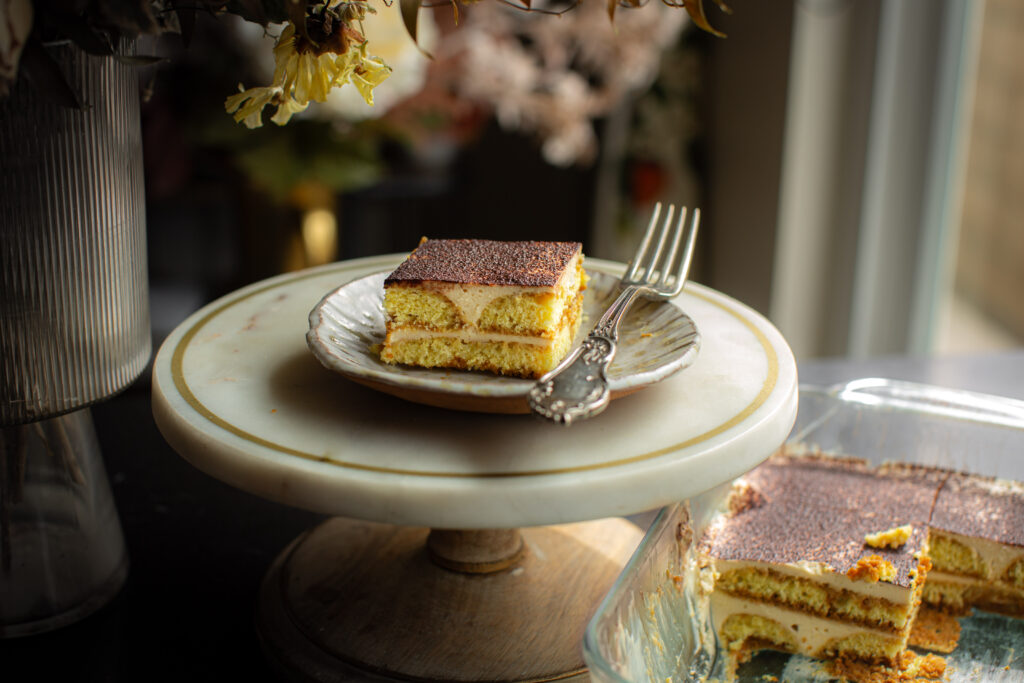
Secondly, I watched a lot of videos of Italian chefs who didn’t speak English (my Italian isn’t great, yet, but luckily, I understood well enough, aided by visual cues) making tiramisu. I discovered that there are a lot of different versions out there, particularly when it comes to the texture and consistency of the cream mixture: some are super light and airy, while others are stiff and custardy. This makes sense–the original version (if Wikipedia is to be believed) was made of egg yolks, while the more recent versions began to incorporate whipped cream.
Finally… I just made my husband eat about 27 different recipes of vegan tiramisu (sometimes 2 in one day!)! As someone who grew up eating his father’s tiramisu since he was a boy, I really had the best test subject at my disposal. I kept tinkering with the recipe, here and there, until he finally declared:
“I think you’ve got it. This is the BEST vegan tiramisu I’ve ever had. In fact, I’d be happy to have this at any Italian restaurant–vegan or not.”

Read about my first time ever meeting my husband’s father
What Are the Main Components of this Vegan Tiramisu?
My main objectives in developing this vegan tiramisu recipe were to (a) get my husband to say it could go toe-to-toe with his father’s, and (b) make it easy enough that home cooks (like yourself!) could make this in their own kitchens. Hence, I stuck to the following four classic components of my father-in-law’s tiramisu:
- Ladyfingers. Anthony made it abundantly clear–multiple times–that his father’s version did not have cake pieces masquerading as ladyfingers. Ladyfingers are cookies, not cake! I’d seen many vegan versions of tiramisu ditching the ladyfingers altogether (it’s rather hard to find vegan ladyfingers), and simply replacing them with a cake layer. I quickly disposed of that idea and, with grim determination, set out to perfect the vegan ladyfinger.
- Mascarpone Cream. Plant-based desserts that call for whipped cream are always annoying because, let’s face it, we don’t have many good options. I’ve watched countless hours of video purporting to whip plant-based “heavy whipping cream” into stiff peaks, but the truth is–they are usually prohibitively unstable and contain all sorts of gums and other random ingredients that I just don’t want. For the cream filling in this vegan tiramisu recipe, I wanted to stick to mostly simple ingredients (the only exception being vegan cream cheese–more on that later) to which most people have easy access.
- Espresso Syrup. Luckily, the espresso syrup is quite easy, with the only variables being whether one uses real espresso or plain coffee and whether you add a generous splash or two of some kind of spirit. This vegan tiramisu includes two shots of espresso along with some brandy, but you can substitute in instant coffee for espresso and water (or marsala, coffee liqueur, amaretto, etc.) for the brandy.
- Cocoa Powder. While some have taken to adding chocolate shavings or even a chocolate cake layer to their tiramisu, I keep this recipe simple with just a light dusting of cocoa powder right on top of the tiramisu right before serving.
Key Ingredients and Notes on Substitutions for Vegan Tiramisu.


The following are the key ingredients for this vegan tiramisu, including notes on potential substitutions:
- Aquafaba. Aquafaba–or the liquid housed inside a can of garbanzo beans–is necessary to create the unique crumb of ladyfingers. Ladyfingers–sometimes thought of as “sponge fingers”–are full of air pockets that perfectly absorb and hold the deep, rich coffee flavor of espresso. The traditional ladyfinger recipe calls for egg whites that are whipped to stiff peaks. Thanks to science, chickpea brine does exactly that–whip to stiff peaks, thus forming the backbone of our vegan sponge fingers. Unfortunately, there is no available substitute for this ingredient, so bust out that can opener and get friendly with some bean juice.
- All Manners of Tofu. Look–you cannot be surprised that The Korean Vegan is attempting to find all sorts of ways to use tofu in her delicious dessert recipes. But hear me out! The softer tofus we use in this recipe impart little to no flavor and because tofu is curdled, like mascarpone cheese, it really is the most sensible plant-based alternative to the real thing that doesn’t incorporate too many unknowable ingredients.
- Soondooboo. This recipe calls for soondooboo, the softest of the tofus (softer than silken tofu), as the “egg yolk” that typically makes up part of the wet ingredients for our vegan ladyfinges. If you can’t get your hands on soondoboo (which usually comes in a tube, not a box), you can substitute with silken tofu. Neither soondooboo nor silken tofu have any discernible taste, but both will provide the necessary protein structure to help create the necessary air pockets for our ladyfingers.
- Soft Tofu. This recipe calls for soft tofu, which is firmer than silken tofu, but not as firm as medium tofu (I know, you had no idea there were so many gradations of firmness in tofu!), for the mascarpone cream. While many plant-based tiramisu recipes rely on coconut cream or raw cashews, I decided to go with something that has less flavor and fat. I don’t really like coconut cream or coconut milk because yes I can taste the coconut I can always taste the coconut and I don’t want to taste the coconut. I don’t like raw cashews for this because it is far too heavy. It doesn’t “whip,” it just… pastes. Soft tofu is thick enough to “set” in the fridge and provides a slight hint of flavor that, in my mind, mimics cheese. If you can’t get your hands on soft tofu, you can substitute with silken tofu, though it may be more difficult to set than soft tofu.
- Tofu Based Vegan Cream Cheese. To keep things consistent, I prefer using a tofu-based cream cheese for the mascapone cream layer. I find that the consistency of cream cheese provides the best result when it comes to ensuring that the mixture properly sets (instead of spilling out into a puddle when you cut into your tiramisu–that happened with my least favorite iteration). A tofu-based vegan cream cheese (like Tofutti), in my experience, will impart a very minimal flavor that doesn’t “fight” with the flavor you get from the soft tofu (or silken tofu) you’re also using in this recipe. Of course, if you don’t have access to Tofutti or a good tofu-based cream cheese, go with whatever vegan cream cheese you prefer. If you cannot find vegan cream cheese, you can substitute in vegan sour cream or vegan yogurt, though both of these will yield a much softer, more liquid-y filling.
- All Purpose Flour. I usually don’t call out an ingredient as plain-Jane as all purpose flour, but having experimented with self-rising, cake, and all purpose flours for this recipe, I can categorically say that you really want to use all purpose flour for this vegan tiramisu recipe. Although I originally thought the finely milled cake flour would be superior when it came to creating a light, fluffy, ladyfinger, I soon discovered that cake flour lacks sufficient protein to create structure around the air-pockets created by the whipped aquafaba. Before you ask–I have not tested this recipe using a gluten free flour blend. Having worked with a lot of gluten free flour blends (including my own), I imagine you could achieve a denser, chewier cookie that might not have the characteristic air-pockets and might be prone to falling apart unless handled with care–but would still be QUITE delicious!
- Caster or Superfine Sugar. With the exception of powdered sugar (see infra), this recipe for vegan tiramisu requires exclusively caster sugar or “superfine sugar,” as it’s often referred to in the United States. Caster sugar is lighter than regular sugar and as such, does a much better job of dissolving into our various syrups and batters, while ensuring even distribution. However, if you can’t find superfine sugar, you can substitute with regular granulated organic cane sugar–it just may take a little longer to ensure the sugar is properly dissolved or incorporated.
- Espresso. If you’re a coffee connoisseur, then you already know there is a rather appreciable difference in flavor between espresso and straight up coffee. This vegan tiramisu draws upon the deep, velvety flavors of espresso to elevate this “casserole.” That said, if you don’t have access to espresso or can’t be bothered (I can relate!), just substitute in a very strong coffee (you can even use instant coffee!).
- Cocoa Powder. The light dusting of cocoa powder at the very end is definitely a key ingredient to this vegan tiramisu, so don’t skip it! I prefer the deep, complex flavor of Dutch processed cocoa powder, but any good cocoa powder will do. And yes, you can also substitute with cacao powder!
Equipment You’ll Need for this Vegan Tiramisu.
The following is equipment that will ensure a pleasant experience in your kitchen as you make this vegan tiramisu:
- Stand Mixer and/or Hand Mixer. Look, the aquafaba isn’t going to whip itself into stiff peaks! Your best option is a stand mixer with the balloon whisk. Barring that, you can use a hand mixer–it’ll just take twice as long and your hand will likely get a little tired. I would not try whipping the bean juice by hand–it will end in frustration. Unfortunately, you cannot use a food processor for this–I tried it and all I managed to get was a weak foam.
- High Speed Blender. In order to ensure that the tofu is smooth and pucker free, you’ll need a high speed blender to create the mascarpone cream of your dreams! No need for anything fancy–just a good, reliable blender will do!
- Piping Bag or Ladyfinger Baking Molds. I’ve tried both the piping bag and the molds and my preference is the former. While you might get perfectly uniform ladyfingers if you use the molds, they’re very difficult to find and resulted in a bunch of broken fingers (not my fingers) when I tried to dislodge them. If you go with the piping bag option, make sure to use a large piping bag, filled only halfway, and a 1/2 inch plain piping tip.
- Sifter. This is one of those recipes where I’m telling you–you want to use a sifter. I know, they’re a pain in the butt and tend to make a mess, but in order to preserve all the hard work you put into creating your beautiful vegan meringue, you want to make sure your flour remains as fluffy as a cloud. If you don’t have a sifter, just use a good sieve to sift your dry ingredients.
- Scale. You all know this already: I prefer using a scale for all my desserts and baking recipes. It will ensure the kind of precision you’ll need for a recipe involving things like “stiff peaks” and “sifting” and “structure.” None of these words need to be intimidating–I promise. But you’re life will be made easier if you have a good scale. They’re super cheap and very durable. I’ve been using the same one for a decade.
How to Make the Components of the BEST Vegan Tiramisu.
I want this process to be as easy as possible for you, so let’s break this recipe down in the following four parts: (a) vegan mascarpone cream, (b) vegan ladyfingers, (c) espresso syrup, and (d) assembly.
How to Make a Delicious and Effective Vegan Mascarpone Cream.

The first thing you’re going to prepare for this vegan tiramisu is the vegan mascarpone cream. As we discussed above, there are generally two camps when it comes to the consistency and texture of the mascarpone cream: light and fluffy, with the incorporation of whipped cream; OR, stiff and set, with an emphasis on the mascarpone. This version aims for something in between, that draws upon the advantages of both–something light enough to qualify as a real “pick me up,” while not being overly liquid-y and unstable (this is not supposed to be a pudding!).
Luckily, making this vegan mascarpone cream is about as easy as making your post-workout smoothie (and may even contain some of the same ingredients!). Just blend the following in your high speed blender:
- 350 grams (~ 1 1/2 cups) soft tofu (can substitute silken tofu)
- 120 grams (~1/2 cup) vegan cream cheese (can substitute vegan sour cream or vegan plain yogurt)
- 170 grams (~3/4 cup) vegan butter, melted
- 120 grams (~1/2 cup) caster sugar (can substitute organic granulated cane sugar)
- 1 teaspoon vanilla extract
Give it a taste and impress yourself!! Now, stick it the fridge while you work on the rest of your vegan tiramisu.
How to Make Vegan Ladyfingers that Taste and Act Like the Original.
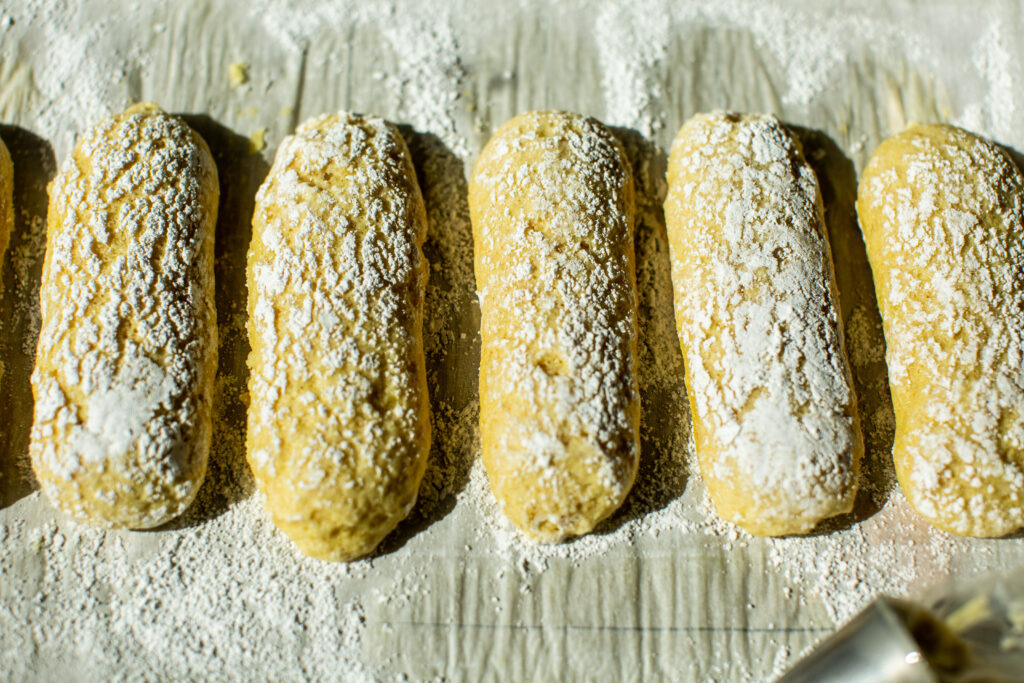
Now that you have the easy part out of the way, let’s focus on the vegan ladyfingers for your vegan tiramisu. I found developing the recipe for these to be akin to solving a very tricky math problem that, once mastered, reveals itself to be fairly straightforward.
The Vegan Meringue.
In order to create your “sponge fingers,” the name of the game is air-pockets. In traditional tiramisu, egg whites are aerated to create stiff peaks. For this vegan tiramisu, we’re going to use aquafaba. First, get your stand mixer going on the aquafaba. Add a little bit of cream of tartar (helps with stabilizing the meringue) along with 120 grams (~1/2 cup) of aquafaba. Using the balloon whisk, whisk on high until your bean juice magically transforms into a stiff, white meringue–one that doesn’t drip off your whisk even when you hold it upside down. This usually takes about 8 minutes if you’re using a stand mixer and about 15 minutes if you’re using a hand mixer.

Tip: If you’re using a hand mixer, make sure you select a stainless steel bowl that is small enough to create some “depth” for your aquafaba. If the bowl is too shallow, your mixer will not adequately aerate your aquafaba to create a meringue.
Once you’ve whipped your aquafaba into stiff peaks, add 90 grams (~1/3 cup) of caster sugar to the meringue and resume whisking for 2 minutes, until it becomes nice and glossy.
The Vegan “Egg Yolk” Custard.
If you’re using a stand mixer, now’s your chance to multi-task! While the machine is whipping your aquafaba, use your idle hand mixer to create the “egg yolk custard” part of this recipe. After watching numerous videos of non-vegan ladyfinger preparation, I concluded that ladyfingers require a fatty, protein component that imparts flavor, richness, structure, and a little color!
For this, just mix together 30 grams (~2 generous tablespoons) of melted vegan butter, 45 grams (~3 tablespoons) of soondooboo (or silken tofu), 50 grams (~3 1/2 tablespoons) of caster sugar, 2 teaspoons of vanilla extract, and 1/4 teaspoon ground turmeric (which technically turns this vegan tiramisu into a superfood 😂).
The Flour Mixture.
The dry ingredients for your vegan ladyfingers are pretty standard: 240 grams (~2 cups) of all purpose flour, 40 grams (~1/4 cup) of corn starch, 1/4 teaspoon of sea salt, and 2 teaspoons baking powder. Make sure to sift these dry ingredients!!! Give them a good whisk to make sure all your baking powder isn’t sitting in one part of your bowl and set it aside until your meringue is ready.
Make Your Ladyfinger Pastry Dough.
Thanks to The Great British Baking Show (I’m a MASSIVE fan), I’ve learned all sorts of things about baking non-vegan things without actually baking them! For example, I’ve learned what “choux pastry” is–the light, airy dough that turns into your favorite French desserts, like eclairs and cream puffs. Heavier than batter, but not as dense as cookie dough, the consistency of choux pastry provides a great benchmark for our ladyfingers dough.
First, incorporate the meringue into the yellow custard mixture, by folding the meringue in–circle your silicone spatula around the rim of your bowl and then down the middle. Keep repeating this motion until your meringue and custard are integrated. Next, add the flour mixture into your wet ingredients in three parts–this will ensure that your meringue doesn’t collapse from the weight of your flour. Once again, use the “around and down the center” motion with your spatula, until the flour is completely incorporated. Your dough will be soft and slightly pockmarked.
Pipe Your Vegan Ladyfingers.

Preheat your oven to 350° F. Fit your piping bag with a 1/2-inch plain tip and fill it no more than halfway (this is to give your forearms a break) with your pastry dough. Set it aside and get your baking sheets ready (I always end up using two, with about 8 to 9 ladyfingers each, for a total yield of 16 to 18 ladyfingers) by measuring out parchment paper to line each sheet.
Using a pencil and a ruler, stencil out 4-inch lines on your parchment paper that are at least 3 inches apart (your ladyfingers will spread in the oven). Dab a little bit of your dough onto the four corners of each sheet of parchment paper (this will make sure your parchment paper doesn’t move around) before flipping it over (so that you don’t pipe your dough onto lead!).
Next, gently pipe your dough onto the lines you stenciled, using even pressure from the top to the bottom of each ladyfinger. Twist up to create the “end” of your ladyfinger or use a pair of kitchen shears to snip the dough. Before placing them in the oven, generously dust them with powdered sugar–this is an incredibly important step, as the powdered sugar will not only give the ladyfingers their hallmark puckered texture, but will also ensure they do not spread too much in the oven (and turn flat).
Bake Your Vegan Ladyfingers.
Place your baking sheets on the center rack of your preheated oven and bake for 15 to 17 minutes, until the bottoms are just beginning to brown. Remove them from the oven and allow them to cool for about 5 minutes before transferring them to a wire rack. Allow them to cool for at least 30 minutes before assembling your vegan tiramisu.
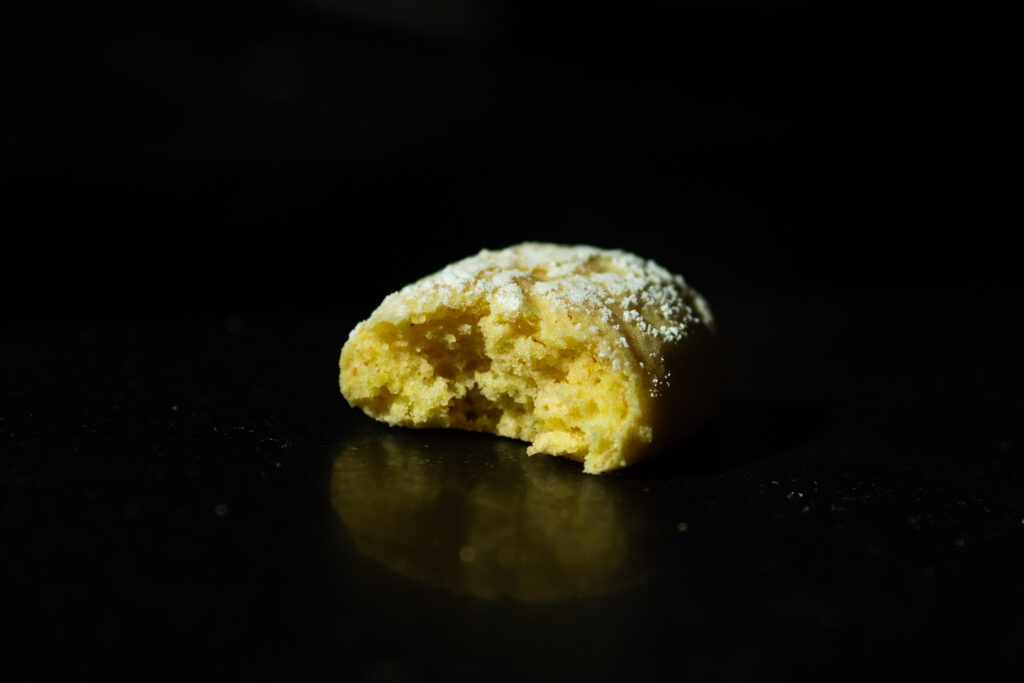
How to Make a Delicious Espresso Syrup.

The classic tiramisu includes a bold coffee flavor and this vegan tiramisu is no different! Making the espresso syrup is as easy as 1-2-3: simply mix together your espresso (or strong coffee) with 3 tablespoons of caster sugar and a splash of brandy (or marsala wine, coffee liqueur, or water). Done! Pour your espresso syrup into a shallow bowl (I like to use a 3 x 5 glass tupperware) and allow it to cool.
Now it’s time to assemble this epic vegan tiramisu!
How to Assemble Your Vegan Tiramisu.


Finally–the fun part! Time to assemble your vegan tiramisu!
Let’s start with the dish that will be housing this glorious dessert. Although the earlier versions of tiramisu were made using round glass dishes (kind of like trifles), I prefer using a rectangular glass container, specifically an 8-inch x 5 1/2-inch x 3-inch container. This ensures your vegan tiramisu has a good height (or regal stature!) when it’s sliced and served.
For the first layer of your vegan tiramisu, dip half your ladyfingers into the espresso syrup, allowing them to soak in its coffee-bath for at least 3 seconds. You don’t want to give them too quick a bath–otherwise it won’t have time to really absorb enough espresso (I learned this the hard way). I like to flip them over to ensure that both sides have equal opportunity to soak. Then, layer them along the bottom of your container, cutting them if necessary to cover any empty spaces.

For the second layer, remove your vegan mascarpone cream and, using the back of a spoon or offset spatula, spread half of it evenly over the soaked ladyfingers.
Repeat with the remaining ladyfingers, espresso syrup, and mascarpone cream. Your vegan tiramisu should come right up to the top of your pan (if you’re using the one I am) and you should be all out of your ingredients (I sometimes have 1/2 a ladyfinger left).
The Hardest Part of this Vegan Tiramisu Recipe.
WAIT.
Cover your vegan tiramisu with plastic wrap or other airtight lid and place your nearly complete vegan tiramisu in the refrigerator for at least 6 hours, preferably 24 hours.
Why do you need to wait?
Because your ladyfingers need time to soak in the espresso syrup and get soft enough to make this “not just cookies with cream.”
Once you’ve allowed your vegan tiramisu to marinate, dust it with a little cocoa powder before cutting in!
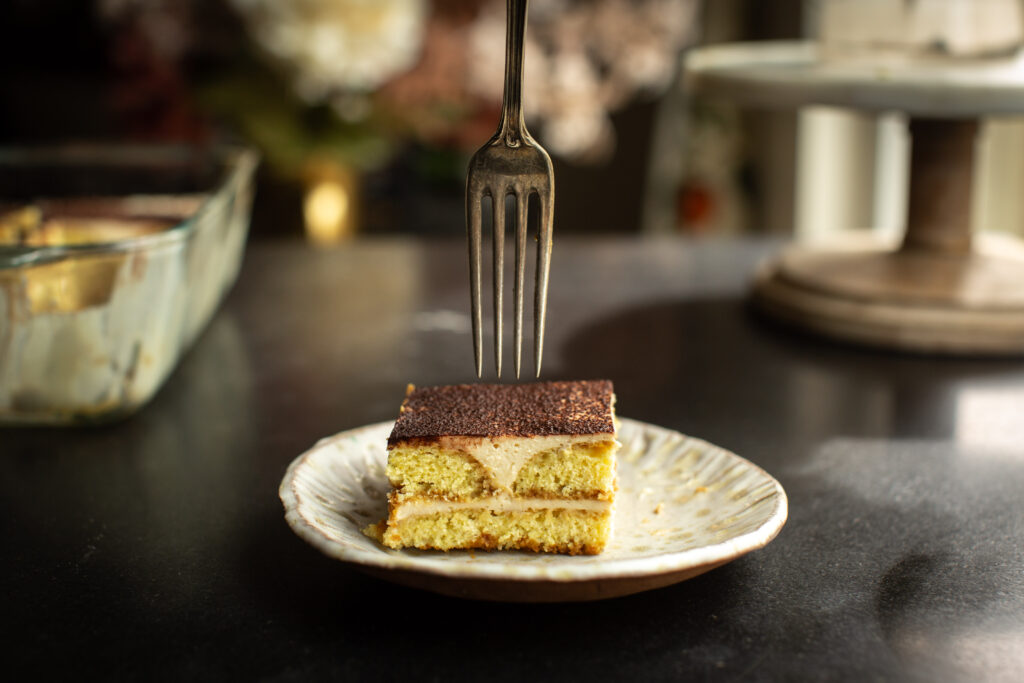
Storing Your Vegan Tiramisu.
My husband always says that you know your vegan tiramisu is good when, after the second day, you can see a little bit of the espresso syrup pooling around the bottom of your pan. This is one of those desserts that taste better with time.
But how long will it last? Well, in our house, usually only 2 days 🤣 But generally speaking, your vegan tiramisu should last up to 5 days, so long as it’s stored in the refrigerator in an airtight container.
Video: Watch Me Make It!
Frequently Asked Questions.
Is tiramisu made from tofu?
The traditional tiramisu is not made from tofu. However, many vegan versions, including this vegan tiramisu, use various kinds of tofu to make a plant-based alternative for the mascarpone cream that you find in traditional tiramisus.
Does all tiramisu contain raw eggs?
Nope! Not even the non-vegan versions necessarily contain raw eggs. In fact, it wasn’t until later on in tiramisu’s evolution that certain regions began to add raw eggs to their recipes. For those who are squeamish about eating anything with raw eggs (I can’t say I blame ya), this vegan tiramisu contains no eggs!
Does tiramisu have dairy in it?
The traditional tiramisu definitely contains dairy–in the ladyfingers and the mascarpone cream. This vegan tiramisu is dairy free!
Recipe Card

Dreamy Homemade Vegan Tiramisu.
Equipment
- stand mixer
- hand mixer
- high-speed blender
- piping bag
- 1/2-inch plain tip
- 2 baking sheets
- Parchment paper
- sifter
- baking scale
Ingredients
Vegan Mascarpone Cream
- 350 grams (~1 1/2 cup) soft tofu (can substitute silken tofu)
- 120 grams (~1/2 cup) vegan cream cheese (can substitute vegan sour cream or plain vegan yogurt)
- 170 grams (~3/4 cup) vegan butter, melted
- 120 grams (~1/2 cup) caster sugar (can substitute granulated organic cane sugar)
- 1 teaspoon vanilla extract
Vegan Ladyfingers
- 240 grams (~2 cups) sifted all purpose flour
- 40 grams (~1/4 cup) corn starch
- 1/4 teaspoon sea salt
- 2 teaspoons baking powder
- 30 grams (~2 generous tablespoons) vegan butter, melted
- 1/4 teaspoon ground turmeric
- 2 teaspoons vanilla extract
- 45 grams (~3 tablespoons) soondooboo (can substitute silken tofu)
- 120 grams (~1/2 cup) aquafaba
- 1/4 teaspoon cream of tartar
- 140 grams caster sugar, divided into 90 grams and 50 grams (~1/3 cup and ~3 1/2 tablespoons)
- 28 grams (~1/4 cup) powdered sugar
Espresso Syrup.
- 2 shots espresso (can substitute 1/2 cup strong coffee)
- 2 tablespoons brandy (can substitute marsala wine, coffee liqueur, or water)
- 3 tablespoons caster sugar (can substitute granulated organic cane sugar)
- 1/4 cup cocoa powder
Instructions
Make the Vegan Mascarpone Cream
- To make the creamy filling, blend the soft tofu, cream cheese, sugar, melted butter and vanilla until smooth and creamy (about 1 minute). Place the mixture in the fridge to stiffen while you make the ladyfingers.
Make the Vegan Ladyfingers.
- To make the ladyfingers, preheat your oven to 350° F. In a large bowl, whisk together flour, corn starch, salt and baking powder. Set aside.
- In the bowl of a stand mixer, add the aquafaba and cream of tartar. Using the balloon whip attachment, whisk on high until the aquafaba whips into stiff peaks, about 8 minutes (if using a hand mixer, it will take up to 12 minutes). Make sure to scrape down the sides with a spatula, as needed.
- Once you achieve stiff peaks, gently add in 90 grams of the sugar. Whip at high speed until the mixture is stiff and glossy (about 2 minutes).
- Using a hand mixer, mix the vanilla extract, melted butter, ground turmeric, remaining caster sugar (50 grams) and silken tofu on high until completely smooth (around 2 minutes). This is the “custard” mixture.
- Gently fold the whipped aquafaba mixture into the custard mixture by using a circular motion around the bowl and then cutting down the middle to incorporate the aquafaba. Continue this motion until the meringue is completely incorporated and the mixture is pale yellow.
- Gently fold in one third of the flour mixture, until completely incorporated. Incorporate the remaining flour, one third at a time. Once mixed, the dough will be fairly sticky and thick (much thicker than a cake batter). Scoop the pastry dough into a piping bag fitted with a 1/2-inch plain tip. You can also just use a plastic Ziploc bag with one of the corners snipped to make a 1/2-inch hole.
- Line a baking sheet with parchment paper (I usually end up needing two baking sheets, so plan ahead). If you want uniform ladyfingers, use a ruler to draw lines 4-inches long on the parchment paper (make sure they are about 2 inches apart as the cookies will spread in the oven). Flip the parchment paper over so that the side with the pencil markings are down (you don’t want graphite on your cookies!). Dab little bits of the dough on the underside of your parchment paper to keep it in place.
- Pipe 4-inch long “fingers” onto the parchment paper, leaving at least ½-inch between the fingers. I usually end up with about 18 ladyfingers. Dust the fingers generously with powdered sugar and then place them on the center rack of a preheated oven. Bake for about 14 minutes, until the cookies are fairly solid. Set aside and allow them to cool for at least 20 minutes.
Make the Espresso Syrup
- Make the espresso syrup by mixing together the espresso (or strong coffee), alcohol (or water), and caster sugar, until the sugar has completely dissolved. Allow it to cool for 10 minutes before beginning assembly.
Assemble the Vegan Tiramisu
- Soak the ladyfingers in the espresso syrup for about 3 to 5 seconds each, flipping them over if necessary. Place the soaked “fingers” on the bottom of your pan.
- Pour half of the creamy filling over the top of the ladyfingers. Repeat soaking and placing another layer of ladyfingers on top of the filling. Pour the remaining creamy mixture over the ladyfingers.
- Cover the vegan tiramisu with plastic wrap or other air-tight lid and place it in the refrigerator for at least 6 hours, if not overnight. Dust with cocoa powder before serving.
Questions & Comments
March 13, 2024
Join The Discussion
March 13, 2024
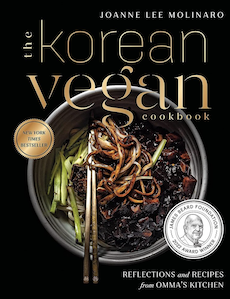
Thank you so much for all the trials and research you put into creating this recipe!!!
This is absolutely THE BEST Vegan Tiramisu I’ve ever had after trying so many recipes!!
10/10 highly recommend making this recipe, it’s so easy to follow, there are no good excuses to not make this. Go on stop reading this and go get this deliciousness in your life!!!
(Yes all the exclamation points are valid, you will only understand the excitement after having a taste of this!!!)
Side note, I made this for my friends birthday, she is half Korean, half Italian and her favorite dessert is Tiramisu, her words “This Tiramisu is Heavenly, I’ve died and gone to heaven!”
Delicious! Made as written (:
Really struggled with piping the dough, but tasty anyway.
I am going to make the tofu from scratch next time! I want to see what that’s like.
So glad it turned out well and I can relate to the piping challenge. My forearms were sore the next day! 😅 good luck with the homemade tofu!!!
Made this for my mom and she loved it!
Whoohoo!!! I’m so happy!!!
I think the ladyfinger recipe is perfect. The other components are a WIP for me. I personally did not like the tofu in the cream, it gave an unpleasant aftertaste. Moreover, I think that adding cocoa powder and sugar to the coffee mixture was unnecessary. The chocolate is overpowering and the sugar is unnecessary. The tiramisu withheld it’s structure so that’s good.
Thank you! The ladyfingers are definitely the most difficult part of this recipe, so glad it worked out for you. Re: the tofu-I asked a ton of ppl (vegan and non-vegan) whether they could taste it and all of them reported they could not. Maybe they were just being polite? LOL. It could also be the kind of tofu you’re using–some tend to have more of a “taste” than others. Finding a stable “cream” is always a challenge for plant-based folks! As for the cocoa powder–it’s not supposed to be added to the espresso syrup–it’s merely dusted on at the end of the fully formed tiramisu. I agree the caster sugar to the espresso can be omitted, though I think some ppl might find it a bit strong otherwise. Thank you!
I gave the tiramisu to other people and they didn’t taste the tofu so maybe it’s just a me thing. I have such a bad habit of skimming recipe so the cocoa powder thing was my bad. Makes sense now.
This recipe blows my mind! Absolutely delicious! I used yoghurt and a good processor instead of a high speed blender (really can’t do it with a hand held mixer!) which took a second but when it came together 🤯 so delicious!! Thanks for this recipe!
YAY!!!! I’m so glad you enjoy this recipe Anna!!!!
This is an amazing recipe! I never had tiramisu before going vegan, but it’s my non-vegan husband’s favourite dessert and he said it was top tier. We were both blown away.
Due to availability of ingredients, I made a couple of very minor subs that I don’t think deviate in any substantial way from the recipe as written:
-I couldn’t find Tofutti cream cheese and subbed Tofutti sour cream as the recipe suggests. The flavour was excellent and the texture was not at all loose–it perfectly maintained its structure once cut. Tofutti sour cream is much thicker than other vegan versions so you might have problems with structural integrity if you use a different brand.
-I used 1tsp lemon juice to hold the structure of the meringue for the lady fingers in place of cream of tartare and it worked perfectly.
The only thing I would change in the future is reducing the turmeric from 1/4 to 1/8th a tsp. My lady fingers were very yellow, but YMMV.
Genuinely a really excellent recipe. Make this as soon as you can.
Catherine, this makes me oh so happy!!! I’m so glad you and your husband enjoyed it and applaud the modifications you made! Hopefully, this recipe will be one you make for all those special occasions in your future! <3
Looks delish! Do you think I can use 1 to 1 gluten free flour with the same results??
It looks devine. Love love love tiramisu. I have another challenge for you. Have you ever made a gluten free version of the lady fingers / sponge? Everytime I try swapping GF flour for normal flour the sponge just turns to crumbs. Fingers crossed
My Favorite desert Veganised! wow, i really wana try this!
Hi, in the ingredient list the caster sugar for the dough is divided but then the instructions don’t mention the divide!
Doh! Thank you! It’s been fixed—90 grams to the whipped aquafaba and 50 grams to the “egg yolk custard.” Thank you so much for catching this and can’t wait for you to try the recipe!
Thanks and thank you for the recipe!
Really great recipe!
Thanks Judy!!